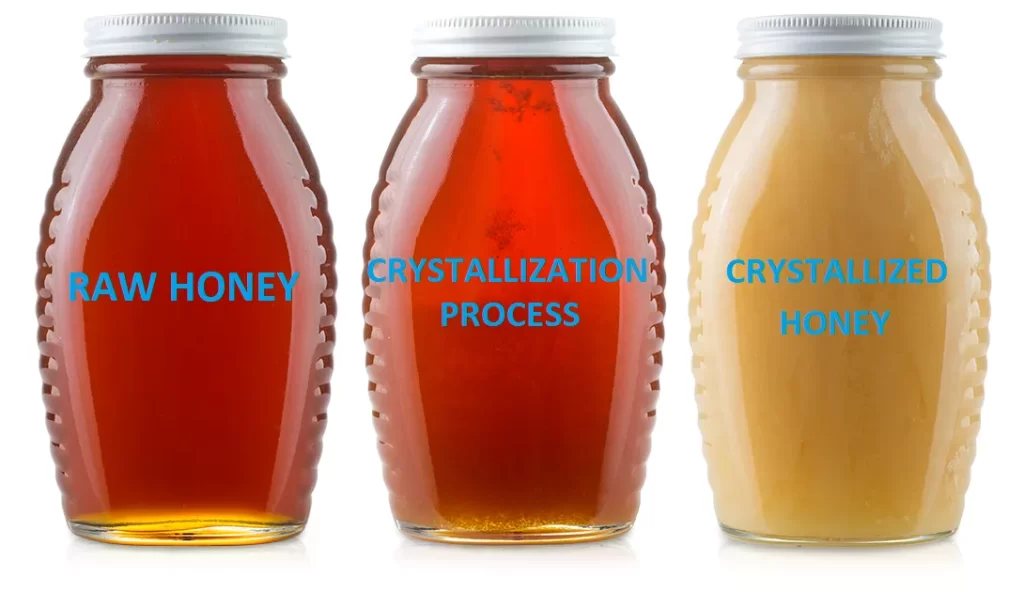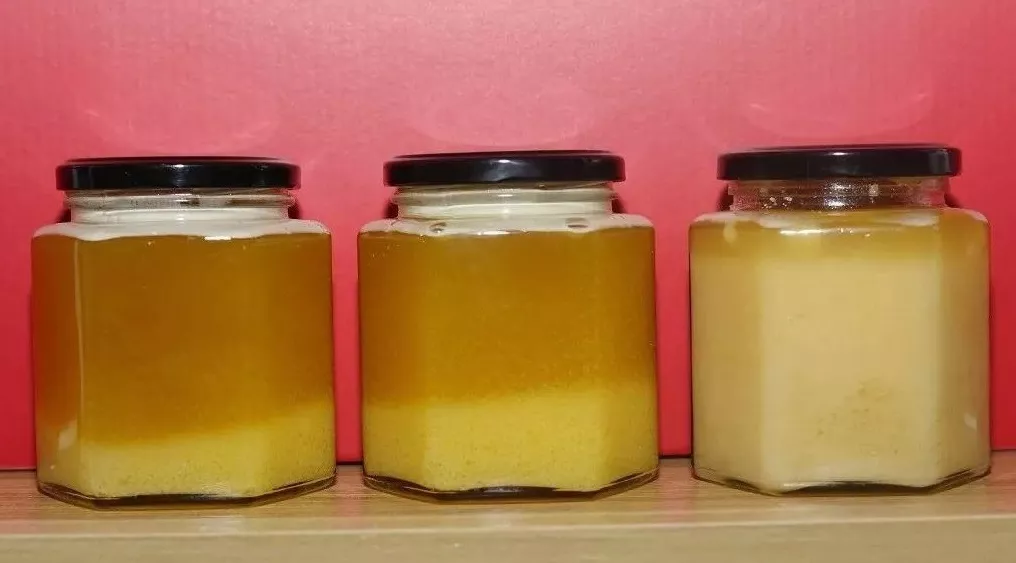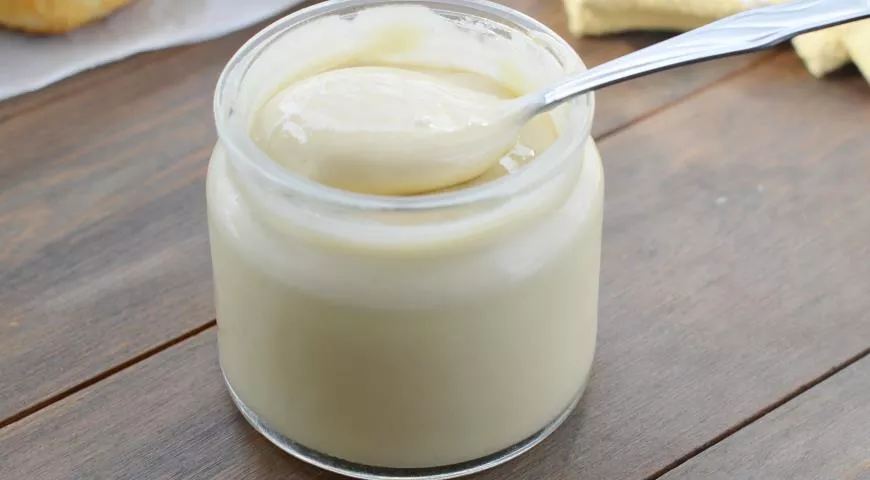Honey usually comes in two different forms; a clear liquid honey and a cloudy solid creamy honey. Both can be purchased in stores or at local farms or beekeepers. Cloudy honey is often used as a flavoring for food, while liquid honey is more commonly used in recipes and beverages. Cloudy honey may also mean that the crystallization process has occurred. At this point, the sugar will solidify into runny honey, leaving a firm consistency and cloudy appearance.
If the honey is cloudy, it can mean two things. Either the honey is made creamy and tied together in a firm consistency. Or your honey has crystallized. Both types are safe to eat. Creamed honey is cloudy, while crystallized honey is a process that occurs over time and sugar particles make it appear cloudy.

If you’re a true honey lover like me, you know that honey is a true super food. Its flavors are also very diverse, with millions of different types to choose from and try. You’re sure to find the perfect honey jar to suit your taste buds and culinary needs. My favorite so far is solid cloudy honey. If you love cloudy things but don’t know how or why it does, then read on to find out exactly what cloudy honey is.
What Does Cloudy Honey Mean?
When honey is cloudy, it can indicate two things. The first is that this honey is made this way and has a solid texture rather than a liquid form. The second is that your honey has crystallized, which means the sugar granules have solidified. I’ll start by looking at store-bought cloudy honey and the process of getting this delicious result.
Cloudy Honey That You Bought At The Store
Runny honey is more common than cloudy honey. This is because the natural consistency of honey is runny. This is the translucent golden honey usually found in the preservation section of your local supermarket. This honey is bottled and can be squeezed and poured over food for use in recipes and sweetened beverages.
Cloudy honey, on the other hand, is more commonly used as a condiment for foods like croissants, toast, and cakes because of its firm consistency. The process of obtaining cloudy and solid honey involves whipping raw honey with “seeds.” The “seed” is a small amount of already creamy honey that helps start the process.
A common misconception is that creamed honey contains dairy. That is not real. Creamed honey is just raw liquid honey that has been whipped to a firmer consistency. The beating process breaks up the sugar crystals in the honey by adding air particles. These air particles make the honey appear whiter and cloudier, while achieving a creamy and firm consistency.
If you want to make your own creamy honey, you can follow the steps outlined in this blog post on the AmberDropHoney website. You can buy the “seeds” of creamed honey from your local beekeeper. Make sure you are using a sturdy blender, as honey is dense, it may damage weaker equipment.
What Is Crystalized Cloudy Honey?
Crystallized honey is when sugar particles in a liquid begin to solidify, forming crystal-like particles. This honey is completely safe to eat, and the process can be reversed by gentle heating, which I’ll discuss in more detail later. Crystallized honey becomes cloudy due to the particles.
The sugar granules in honey are not created by chemical changes or anything like that. This is a very natural process that honey goes through; it’s just a rearrangement of the molecules within the substance. Certain types of honey can crystallize faster than others, but this also depends largely on the temperature at which the honey is stored. Refrigerated honey crystallizes more easily than honey stored in the cupboard.

If you keep honey in the refrigerator, it may crystallize more quickly than if you keep it in the pantry at room temperature. The average room temperature is 68°F. In winter, this can drop significantly, so keep an eye on this change when storing honey. It can crystallize faster in winter.
Cold conditions cause honey to crystallize faster because the glucose in honey separates from water much faster than warm temperatures. In winter, honey in beehives can also go through this process. If your honey crystallizes, this may indicate that your honey is a less processed and nutrient rich product!
Why Do Some Honeys Look Cloudy?
The honey looks cloudy, either because it has turned creamy or because it has crystallized. However, some runny honeys can appear cloudy even if none of the above processes happen. This is due to different pasteurization processes.
Pasteurization is a heating process designed to prolong the shelf life of honey. Honey is a preservative, so it doesn’t technically go “bad”. However, it can crystallize at different rates depending on many different factors, including storage temperature. When the honey is intensely pasteurized, the crystallization process is stopped.
Some pasteurization processes make honey appear “purer” by creating a translucent appearance. So if you have liquid honey in your cupboard that’s “cloudy” or “foggy,” it means it’s closer to its original form and hasn’t been intensely pasteurized.
Raw honey is honey that is extracted directly from beehives and eaten in jars. Raw honey is cloudier and cloudier in appearance than pasteurized honey, because many beehives do not produce crystal clear honey.
Bees use pollen to make honey. The pollen is naturally hazy yellow and opaque. Therefore, natural raw honey is not transparent in appearance, although it is still liquid. What clarifies the appearance of honey is an artificial pasteurization process.
Also, different types of flowers that bees pollinate give honey a different appearance. Some honeys are darker in color, while others are golden yellow. My uncle used to be a beekeeper in the south of Ireland and his honey bees produced yellow meringues.
This is a beautiful honey with a very sweet aromatic citrus flavor. Its color is also cloudy and foggy, rather than translucent. He did not pasteurize the honey. He just filtered it and put it in a jar in raw form. It’s called Wilkie’s Wolf Mountain Honey, and he’s giving it away for free in County Lowes.
While cloudy honey usually means it’s creamy or crystalline, raw honey can also have this appearance. You can ask your local beekeeper about their honey, and if it looks cloudy, you can find out what process it went through to make it look the way it does.
If you buy honey from the supermarket, there may be cloudy honey on the shelves. All honey in supermarkets is mass produced and therefore pasteurized. You probably won’t find raw honey for sale here.
Reasons Why The Honey You Just Bought Turns Cloudy
If after purchase, after a short period of time, the transparent honey becomes cloudy, you should not immediately think that this is fake. It is quite possible that the process of thickening or crystallization begins in the honey.
This actually indicates its excellent quality because all natural honey must go through this process, only that some types of honey crystallize more slowly. Crystallization of honey does not affect its vitamin composition.
The optimal temperature for storing honey is 55 – 59 °F. If the storage temperature is higher, the consistency of bee nectar will remain liquid for a long time, if it is lower, it will quickly crystallize. This is why the honey is cloudy.
At temperatures above 104 °F, it stops forming crystals, glucose begins to evaporate, and the product loses all its useful properties. Moreover, it can even harm the person who consumes it, because high fructose and insufficient glucose can cause a serious allergic reaction. That’s why honey should never be heated above 104 °F.
Honey copes with many diseases, activates the body’s immune system and increases resistance to stress. The main thing is to understand the characteristics of the selected variety, so as not to fall for a counterfeit product.
Is Cloudy Honey Safe To Eat?
Cloudy honey is completely safe to eat. Whether raw, creamy or crystallized. You can eat cloudy honey, no problem. Honey is a preservative and can be preserved for thousands of years. How the product is stored plays an important role here.
Human use of honey dates back 8,000 years and was discovered through records in ancient cave paintings. It was used sacredly by the Egyptians to heal it, and was widely collected for consumption about two thousand years ago. Honey is medicinal, contains many antibodies and enzymes, and is full of nutrients for both the body and the skin.
There is much debate about pasteurizing honey and whether it is a necessary process for human consumption. This is because it can destroy most of the good qualities it contains, making the health benefits of pasteurized honey virtually non-existent. So the question really should be, is clear honey edible and why do we pasteurize it?
Of course, clear honey is also safe to eat. Pasteurization just makes the honey look “cleaner”. However, that doesn’t mean it’s better for you. Cloudy honey in raw liquid form is the best type of honey you can consume to get all the health benefits it has to offer.
It is also important to distinguish creamed honey from raw honey here. Creaming honey is the process of thickening honey by adding air particles, which in turn makes the honey white and cloudy with a firm consistency. Raw honey is the most natural form of honey that comes from beehives.
However, you can cream raw honey if you want. Beekeepers can also do this with raw honey, as some prefer creamed honey to runny honey. In this way, they can provide raw liquid honey and raw cream honey. Whipped cream honey has the same health benefits as raw liquid honey.
Supermarket honey is pasteurized. Some people confuse mass-produced creamed honey with being better for you than mass-produced thin honey. But in fact, it’s not. Pasteurized cream honey loses as many health benefits as pasteurized liquid honey.
While both raw honey and pasteurized honey have health differences, both are fine. Whether they look cloudy or not.
With all that said, it’s not just the look of the honey that determines which one is right for you. It’s all about how it gets to the cabinets and shelves. Always check honey labels and look up local farms and beekeepers to find the best honey.
What Is Creamy Honey And Why Is It Cloudy?

Creamy honey is cloudy due to the way it is processed. The process of obtaining creamy honey includes controlling the temperature of the honey, the crystals of which are broken and a creamy consistency is obtained. Creamy honey is a delicious type of honey, and it is full of medicinal properties, without the addition of additives. This honey is a type of crystallized honey and is simply applied as a spread on bread, biscuit, pastry or pancakes! You may want to try putting a few spoonfuls on top of ice cream or another delicious dessert to enhance the flavor.
Unlike raw honey, which is sticky and dripping, creamed honey takes on a form more like softened butter or peanut butter, making it easier to spread with a knife on bread and other foods.
Creamy honey is completely safe to use!!!
What To Do With Cloudy Honey, How To Fix It?
Fixing cloudy honey depends on what type of honey you have that is cloudy. Once you have purchased creamed honey, its cloudy appearance cannot be changed. However, if you have crystallized liquid honey in your cupboard, you can fix cloudy honey with some heat.
You will need to heat some water with a kettle or stove. Then you have to put the honey jar in the water, being careful not to let any water get into the honey. This can contaminate your honey and cause it to ferment. This is the only time your honey will go bad.
Screw the lid onto the jar, place in hot water, and check for consistency after 15 minutes. If your honey has crystallized to an extreme, it will take a few tries to get it back into liquid form. Once your honey has been heated and returned to its liquid form, it will no longer be clouded by crystallization.
Microwaving cloudy crystallized honey is not recommended as this will kill nutrients. However, if your honey has been pasteurized, it makes no difference since the honey has already been heated. You might want to try heating it in a pot so you don’t burn the honey with electromagnetic waves.
If you bought raw liquid honey and it looks cloudy, you can’t change it. This is what this honey looks like. In its original form, honey is naturally cloudy and hazy. This is where all the nutrients are, so don’t worry if your honey is opaque.
Difference Between Cloudy Honey And Clear Honey
The key difference between cloudy and clear honey can be determined by the process they go through to reach this state. For example, if I were to compare pasteurized liquid honey to pasteurized creamed honey, the difference would be in the process of making them cloudy or clear.
In stores, cloudy honey is usually creamy, while clear honey is runny. Both are pasteurized. Clear honey is what creamy honey looks like before the whipping process. Both have similar levels of nutrients, but very different flavors and very different consistency.
I find creamed honey more flavorful than runny honey. I like the taste very much. However, I use runny honey in my coffee because the creamed honey doesn’t dissolve well enough. Taste and consistency are the main differences between the two, and have a lot to do with your preference and intended use.
It’s not uncommon for people to gravitate to one or the other because of the difference in taste and texture. For example, my grandma likes her cloudy honey, but my mom likes the liquid kind! Both can be used in recipes, drinks, and condiments, however, creamed honey is more commonly used for the latter, while runny is more commonly used for the first two options.
If you want to buy clear honey, it just means that it has gone through a rigorous pasteurization process to achieve this clarity. Some brands of honey call this honey “pure,” but don’t confuse it with “better.” It just means that the honey is filtered and heated many times to give it a glass-like transparency.
Also, creamed honey should not be confused with raw honey due to its cloudy appearance. Creamed honey is clear, flowing honey that has been whipped to a firmer consistency. Both share similar views on nutritional value.
Cloudy honey that has crystallized is different from clear honey because it has begun to solidify. As mentioned above, this process can occur due to several different variants. What matters most is how and where the honey is stored. If your honey is cloudy due to crystallization, the main difference is its gritty taste.
Crystallized honey is great to eat, but it tastes crunchy and sweet with a slight aftertaste. Many people don’t like to eat it in this form because it’s not as tasty as smooth running honey. However, this is the only real difference between this cloudy honey and clear honey.
Now it’s safe to say that you know what cloudy honey means. It all has to do with the process honey goes through and whether it turns creamy or crystallized. Remember to always support your local beekeeper and promote the amazing properties of raw honey!

